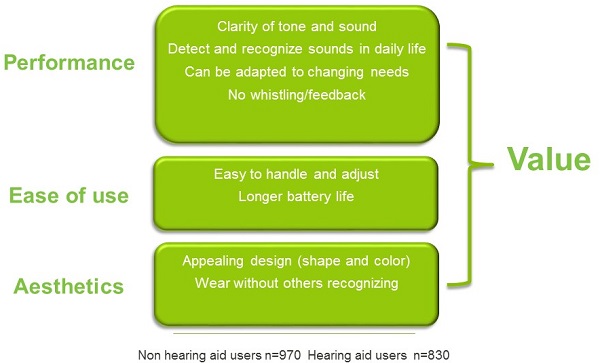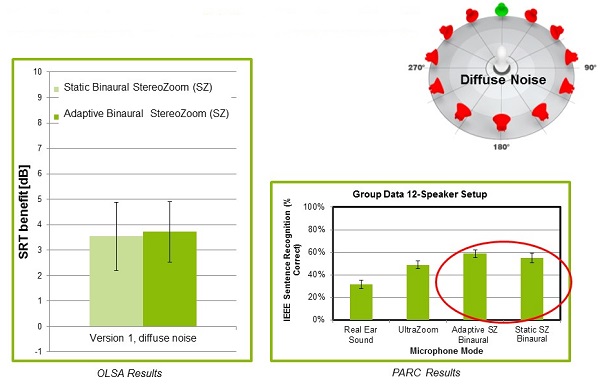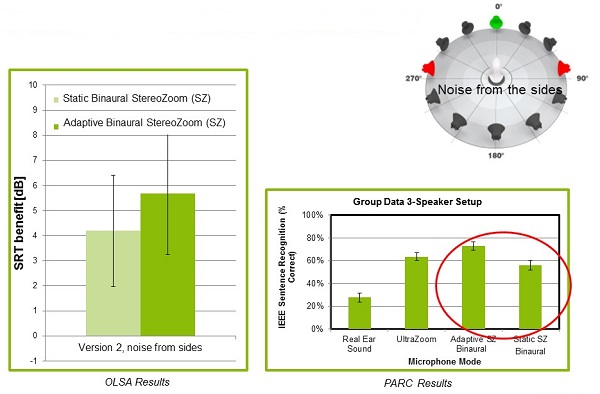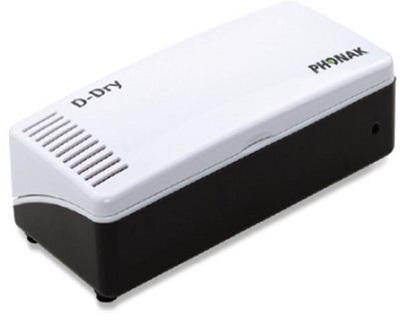Editor’s Note: This text course is an edited transcript of a live webinar. Download supplemental course materials.
Introduction
Dr. Stephanie Watson: This presentation is about the automatic program, AutoSense, in the new Venture product portfolio. As leaders in innovation, we are committed to helping our users live life without the limits of hearing loss.
As a matter of disclosure, I am a clinical customer trainer with Phonak, and I do receive a financial salary with them. I am also a Phonak Venture wearer.
Our learning objectives today are that you will be able to identify the features within AutoSense OS, and detect and analyze why those features are beneficial for hearing professionals and patients alike. You should be able to list the benefits of AutoSense OS and identify the seven base programs that AutoSense OS is able to transition seamlessly between.
Phonak conducted a consumer needs survey of 1,800 hearing impaired men and women. Some of them were wearing hearing instruments and some were not. The consumers’ average age was 40 years. We asked them the single most important need regarding their hearing instruments. This demographic reported those needs as easy listening situations, being able to communicate, intelligibility in multiple listening environments including TV or cellphone use, clarity and tone, and a natural sound quality of that hearing instrument. They also wanted to be able to adapt with change when wearing a hearing instrument and wear it comfortably with nice aesthetics.
We know that hearing instruments are comfort first. We have to make it look good, feel good, and then sound good.
Philosophy
Phonak’s philosophy has always been that hearing solutions must exist seamlessly with their listening experience through ease of communication. We are able to develop new ways to enable people to hear in the most challenging listening environments. The basis of the innovation comes from both internal and external studies. Every feature that comes out in our product portfolio is backed by evidence and research.
The hearing aid needs to be able to evaluate different classifiers in a soundscape and precisely pick up on what is important. It has to be appealing to the wearer and be personalized for their individual lifestyle and unique needs. Being able to have certain features that can benefit them throughout their life and require as little interaction as possible is important to patients. They are asking for more automatic features, so as to not have to push the program or volume buttons. They also want easy cellphone use where they can make and receive phone calls.
We performed an internal study of hearing aid users and non-hearing-aid users in five countries. They were asked to rate 82 different needs in terms of importance when it comes to a hearing solution. The four main categories were performance, ease of use, aesthetics, and altogether value (Figure 1).

Figure 1. User-reported categories of hearing aid importance.
For performance, the listeners rated clarity of tone and sound, detecting and recognizing sounds in daily life, adapting to changing needs, and no whistling or feedback as important. We noticed that a lot of that concern came from the non-hearing aid user population.
The second category was ease of use. A hearing aid needs to be easy to handle and adjust with a longer battery life.
The third category is aesthetics. They want an appealing design with shape and color, and it has to be small and discrete.
The three categories come together in value, being able to have something that not only brings benefit to the patient, but is available at a great price point. Value also applies to the audiologist by being able to provide these benefits to their patients.
Venture
The Venture chip is new. It gives a reduction of power consumption when streaming, which means that we are getting much more battery life out of this new chip. It is able to perform dual processing. It also has a new analog-to-digital converter with more memory.
Phonak recognized the value of automatic technology back in the 90’s with AutoPilot. It was introduced in order to access and change more than one program discretely. Then we made leaps and bounds with SoundFlow, which was introduced as being the innovation of blending portions of programs to create an optimized and personalized response to individual sound environments. That is unique to Phonak.
AutoSense OS
AutoSense OS has a new level of automatic ability that offers more seamless benefit of amplification for hearing aid wearers. AutoSense OS mimics the way that the brain analyzes the acoustic scene. Figure 2 is an example of an auditory scene analysis model, which is a popular theory as to how the brain analyzes sound. As the brain receives a sound input, it does much of processing automatically, where features are extracted put into segmentations and groupings. Then it makes an evaluation of the sound.

Figure 2. Acoustic scene analysis comparison of the brain and AutoSense OS.
One the right side of Figure 2, you can see that AutoSense OS is trying to mimic the role of the brain by sorting the sound input, activating appropriate programs or features that are best reflections of that sound environment for the end user. The benefit of this is that it all happens automatically and precisely.
This is a basic auditory scene analysis. The simplest way to separate sound environments would be 100% quiet, which would be omnidirectional, or 100% noise, which would be directional. If we had a hearing aid that did only one or another, we know the response would inaccurate. Furthermore, we live in complex environments, not black-and-white auditory moments. Accuracy is important, and AutoSense OS will accurately recognize that sound environment and blend between programs. Let’s discuss how AutoSense works in the four different performance levels.
Essential (V30)
AutoSense OS is available down to the V30 level. In the Quest chip (Q30), the automatic program was EveryDay Automatic. It did not blend programs and only classified environments as calm or speech in noise. AutoSense OS on the Venture chip allows the blending of programs down to the essential technology level.
Standard (V50)
We have added a comfort-in-noise program at the standard performance level. The Quest chip only had two programs at this level, and now we can blend between three.
Advanced (V70)
We have expanded the dynamic range of our music program, which is an exclusive program in the V70 technology. This levels blends comfort in noise, speech in noise, and calm, but if the hearing aid detects music as the dominant sound source, it will automatically go into a music program. This is an advancement from the Q70 portfolio.
Premium (V90)
There are seven programs in the V90 level. Comfort in noise, speech in noise, calm, and comfort in echo, which is new, are all able to be blended. Three exclusive programs at this level are Speech in Loud Noise, Speech in Car, and the music program. The beauty of the processing speed in the chip is that it provides more programs with better battery life, and at this level, you can get over 200 combinations of program soundscapes.
Binaural Directionality
There are two ways that we utilize binaural directivity in this operating system: Binural VoiceStream and Binaural Synchronization. Binaural VoiceStream is an exchange of the audio signal from one hearing aid wirelessly to the other. This technology makes possible Speech in Loud Noise, DuoPhone, Speech in 360, and Speech in Wind.
Binaural Synchronization gives us programs such as Speech in Car and music. Binaural Synchronization is an exchange of a control signal. The hearing aids are constantly talking to each other; if one hearing aid detects a different listening environment, then it will talk to the other hearing aid and pull it into that same program automatically.
Speech in Loud Noise
This is our third generation Speech in Loud Noise; it used to be called StereoZoom. Speech in Loud Noise actively suppresses noise from the back and the sides. By using binaural VoiceStream technology, we can send information between the two hearing aids using the four-directional-microphone network. The hearing aids will automatically focus on the speech signal to the front in a noisy environment. This is automatic in the V90 and V70 levels, but you can make Speech in Loud Noise a manual program.
Noise does not always come from behind. In a fixed, directional beam former, the fixed focus is at the front with the null always at the back. Sometimes fixed directional beam forms are beneficial, but they can be less effective in a dynamic environment because they cannot move the null point around for noise from varying angles.
We can do a better job at reducing noise by using different polar patterns that move the nulls depending on source of the loudest noise. This is what we call adaptive directional beam forming. Phonak has multichannel direction beam formers that can create multiple beam forming patterns simultaneously for different noises coming from different locations.
How has Speech in Loud Noise been improved? Figure 3 shows a comparison of the Venture microphone modes. UltraZoom is our adaptive beam former for noisy situations. We had that for directional microphones. Fixed StereoZoom uses binaural VoiceStream technology to provide frontal beam forming. We married UltraZoom and fixed StereoZoom to make adaptive StereoZoom. In a loud environment where the noise floor reaches a certain point, the hearing aid will go into speech in loud program, which allows the listener to hear the people in front of them without having to make a conscious decision to put the noise behind them with the speaker in the front.

Figure 3. Comparison of Venture microphone modes.
Program Activation
For Speech in Loud Noise to be automatically activated in AutoSense OS, you have to have two Audéo V90 hearing aids, or two V70 in a manual program. There are certain criteria that must be met in both hearing aids for the program to be activated, which are shown in Figure 4. The hearing aids must detect speech in noise 80% of the time with a noise floor of 67 dB SPL. This noise floor can be adjusted in the Phonak Target software to be more or less sensitive.

Figure 4. Speech in Loud Noise program criteria.
When the input meets these criteria, a timer starts. If the timer reaches 15 seconds, the hearing aids will go into Speech in Loud Noise and stay there for as long as the criteria are met. If one of these criteria falls out, another timer will start for 20 seconds. The hearing aid will go out of Speech in Loud Noise if, after the 20 seconds, the criteria are not met. The complexity of the Venture chip avoids any type of pumping effect.
For stabilization reasons, there are relatively short attack times to change from Speech in Noise to Speech in Loud Noise, and longer release times to change from Speech in Loud Noise to Speech in Noise.
Directional Microphone Validation
Figure 5 shows two different speech-in-noise scenarios. Setup 1 is speech in diffuse noise; noise coming from every direction. Setup 2 is noise from the sides with the speaker in front. Two studies were conducted to validate directional microphone performance in these situations (Appleton & König, 2014; Saoji & Rakita, 2014).

Figure 5. Two speech-in-noise conditions for research.
The diffuse noise environment is good for comparison of the static StereoZoom versus our new adaptive StereoZoom, or Speech in Loud Noise. Both the static and adaptive StereoZoom provide over 3dB of benefit in diffuse noise, and both provide more benefit than UltraZoom and Real Ear Sound (Figure 6).

Figure 6. Directional microphone validation - directional benefit in diffuse noise.
However, when noise is presented from the sides, we see the most benefit from adaptive Speech in Loud Noise. This is the third generation of Speech in Loud Noise, and we are able to provide a directionality benefit of 1.5 dB SNR (signal-to-noise ratio) (Figure 7).

Figure 7. Directional microphone validation - directional benefit with noise coming from the sides.
Another study for directional microphone validation was done using MUSHRA (Appleton & König, 2014). MUSHRA is the German version of the Hearing in Noise Test (HINT). This study compared adaptive UltraZoom, static Speech in Loud Noise (StereoZoom), and adaptive Speech in Loud Noise. Ratings were made of speech intelligibility, suppression of interference, and overall quality of sound. Adaptive Speech in Loud Noise outperformed the other two conditions.
Comfort in Echo
Comfort in Echo is one of the blended programs. All enclosed spaces have a certain amount of echo or reverberation, and this feature is sensitive to pick up reverberation from 0.5 seconds and apply the appropriate amount of gain reduction and cancellation of that noise tail. The overall goal is to reduce the patient’s listening effort and subsequent fatigue in a reverberant environment.
Comfort in Echo works by detecting frequencies where reverberation is dominant and reducing the gain in those bands, leaving the other signals untouched. Early reflections in a reverberant room are followed by a reverberant tail, which is distracting to speech understanding. It takes away the ability to understand speech because it masks softer speech cues. That is why it is hard for hearing aid wearers to understand in a reverberant environment. Comfort in Echo detects and blends the echoes, all automatically in the V90 portfolio.
Speech in Car
Speech in Car is an exclusive program that the hearing aid will access automatically when it detects a car situation. It utilizes binaural synchronization in the Audéo V90. Just one of the hearing aids has to detect the signals of a small environment, such as a car. When one hearing aid changes to the Speech in Car program, it will talk to the other hearing aid and direct it to change programs after a 20-second timer within that specific environment has elapsed.
Speech in Car reduces the low-frequency engine and road noise. The Venture chip has the ability to enable lower noise floors. When the car stops and the hearing aid no longer detects that environment for a sustained period of time, the hearing aid will go back into whatever program is appropriate for the next situation. A validation study comparing the Audéo Q90 to the Audéo V90 showed that 60% of patients reported less effort with Venture, including when listening in a car.
Music
Listening to music is a very personal and sometimes emotional experience. The perception of music can change for a person with hearing loss, especially through the hearing aids. While hearing aids have to provide good speech intelligibility, these parameters do not always translate to music. Speech will always be primary, but for some individuals, music is equally as important. At Phonak, we recognize when you can satisfy your patient in as many listening environments as possible with ease of use, the happier they will be with their hearing instruments and with hearing health care in general.
We have made some improvements to the music program. There is a higher input limit and wider dynamic range, which is important for music, as it is more complex than speech. It has its own compression ratio and a variable release time so that the compression ratio is slower. There are different directionality patterns with omnidirectional, RealEar Sound, and fixed beam forms. The music program has its own microphone modality. It also has WhistleBlock which can be adjusted independently in the music program. Music sounds broad and full; it does not sound “flat” anymore.
Music is an exclusive program within AutoSense OS at the V90 level. It utilizes binaural synchronization. If one of the hearing aids detect music 50% of the time or more, one hearing aid changes to the music program and tells the other hearing aid to join it. A timer will start, and then it will go into the music program exclusively. It will drop out of the program if music is present 30% of the time or less for more than 10 seconds.
A benchmarking study on this music program was done in Denmark by Sense Labs. They used a group of specialized, expert listeners who had good test-retest reliability. The group was comprised of people with and without hearing loss. These participants identified and judged music recordings based upon attributes such as timbre balance, shrillness, reverberation, loudness, dynamics, source separation and treble shadow. This testing was completed over two-hour sessions twice a day for a total of four hours.
All seven samples showed that the Audéo V was closest to what the expert listeners rated as the best music sound quality over three other manufacturer’s hearing aids. It also did not make a significant difference whether SoundRecover was turned on or off.
Phonak Audéo V
We released the Venture chip to the Audéo family first (Figure 8). There are four models, and all have program buttons. The Audéo V10 is a new receiver-in-the-canal (RIC) that uses a size 10 battery and is wireless. We are able to integrate binaural VoiceStream technology. Patients love how discrete this instrument is. We also have the Audéo V312, the Audéo V312 T (T-coil), and the Audéo V 13. That hearing instrument runs on a size 13 battery with a program button and a volume control on board.

Figure 8. Phonak Audéo V product family.
All Audéo V casings are made with a high-tech composite material that comes in the Quest colors, except for translucent. The composite material is strong and will hold up to patients who are rough with the hearing aids.
All of the models and performance levels include the Tinnitus Noise Generation program. The standard and power receivers that are in office are backwards compatible to the Venture. We have streamlined it to make Audéo V receivers standard, power and super power plus. We no longer have the super power receiver for the Venture. Those are not compatible with the Audéo V. You will still have the same domes, slim tips, and C shells.
In the Venture hybrid chip, we were able to improve the power consumption of all the models when streaming wirelessly from hearing aid to hearing aid and from accessory to hearing instrument by 30%. This means people are spending less time changing batteries. When comparing the Audéo Quest and the Audéo Venture, Venture showed a 19% to 40% improvement in battery life in quiet situations. In noisy situations, binaural VoiceStream technology showed a 24% to 33% improvement in battery life, with an average of 30%.
The features in each of the four Audéo models are summarized in Figure 9. The super power plus receiver is new for the Audéo family. You can utilize that super power plus receiver on the Audéo V312, the V12 T and the V13. All of these come in the new design and high-tech composite material. We also have new user guides and hard carrying cases.

Figure 9. Summary of features in the four Audéo V models.
The D-Dry kit (Figure 10) is an electronic hearing instrument cleaning and drying system. The first five minutes sanitizes the hearing instruments, and then it will dry for the set amount of time that the user chooses and automatically shut off. This is a useful accessory for patients who sweat or have excessively oily skin.

Figure 10. D-Dry electronic cleaning and drying system.
Value for the Audiologist
AutoSense OS provides value for the audiologists through its performance, ease of use, and aesthetics as we have discussed today. Being able to give someone a hearing instrument that has an intuitive automatic program allows them to live their life seamlessly, accurately, and precisely. Being able to do a Phonak first-fit in the software lends to the ease of use. Patients are excited that the process does not have to be complex, and they can live their life and hear the things that they have always wanted to hear.
The Audéo V offers wonderful aesthetics in four different models with three receiver powers. The composite material allows you to offer a product that is durable, strong, and will last for years to come.
Evidence
All the evidence and research on our products and features is available on Phonakpro.com. There is a tab for evidence; Phonakpro.com/US has many tabs. Any information that you need as it pertains to the broad Phonak portfolio will also be available on Phonakpro.com.
Summary
Thank you for attending today and learning about the benefits you can offer your patients with the Venture platform. If you have any questions, please contact us or your field representative and we would be happy to help you.
References
Appleton, J., & König, G. (2014). Improvement in speech intelligibility and subjective benefit with binaural beamformer technology. Hearing Review, 21(11), 40-42.
Rakita, L., & Saoji, A. (2014). Directional microphone validation study - unpublished. Phonak Audiology Research Center, Warrenville, IL.
Cite this Content as:
Watson, S. (2015, March). Phonak AutoSense OS: the evolution of automation technology. AudiologyOnline, Article 13646. Retrieved from https://www.audiologyonline.com.

